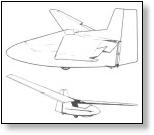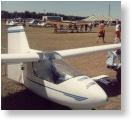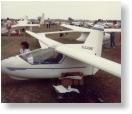| http://www.survol.cjb.net |
Haig "Minibat"
 |
 |
| Two drawings of the Minibat |
Minibat on tow |
 |
 |
| The Minibat on
display in Oshkosh in 1980 |
|
| (click on the pictures to enlarge them in a new window) | |
The "Minibat" ultralight single-seater glider was designed by Larry Haig of Muskegan, Michigan, and made its first flight on March 11, 1979. The Minibat had a cantilever, swept forward wing (the AV-22 also incorporated this feature) and used a reflex airfoil. It was constructed of Kevlar, carbon fibres and foam sandwich with glass fibre covering. The fuselage was made up of two halves joined by the metallic structure which formed the pilot's seat. Wings were demountable in the same way as a conventional glider, and a peculiarity of this machine was that the two ailerons could be raised together to act as spoilers. Extended wing tips were also available, increasing span to 10 meters.
The Minibat was available as fast-build kits for the homebuilder, assembly was said to require only 5 - 10 days using moulded parts. A powered version was planned, using a 3 hp chain saw sustainer engine mounted behind the cockpit and driving a pusher propeller mounted in a slot between the fin and rudder. The Minibat was not a self-launching design but the engine was intended, after launch by auto-tow, winch or bungee, to provide a positive rate of climb.
By January 1982, four Minibats had already had accidents during take-off. It was concluded that this machine should not be made available to just anybody, as it was initially expected. It seems that the airfoil was the major cause for the bad handling characteristics. But yet the Minibat was a very interesting concept of a very light and efficient "minimum" glider.
| Characteristics and performance of the Minibat | |
| Wing span | 7.62 m |
| Length | 2.84 m |
| Wing area | 6.04 m2 |
| Aspect ratio | 9.6 |
| Empty weight | 36 kg |
| Gross weight | 136 kg |
| Stall speed | 56 km/h |
| Max.speed | 202 km/h |
| Glide ratio | 23:1 |
| Sink rate | 0.90 m/sec |